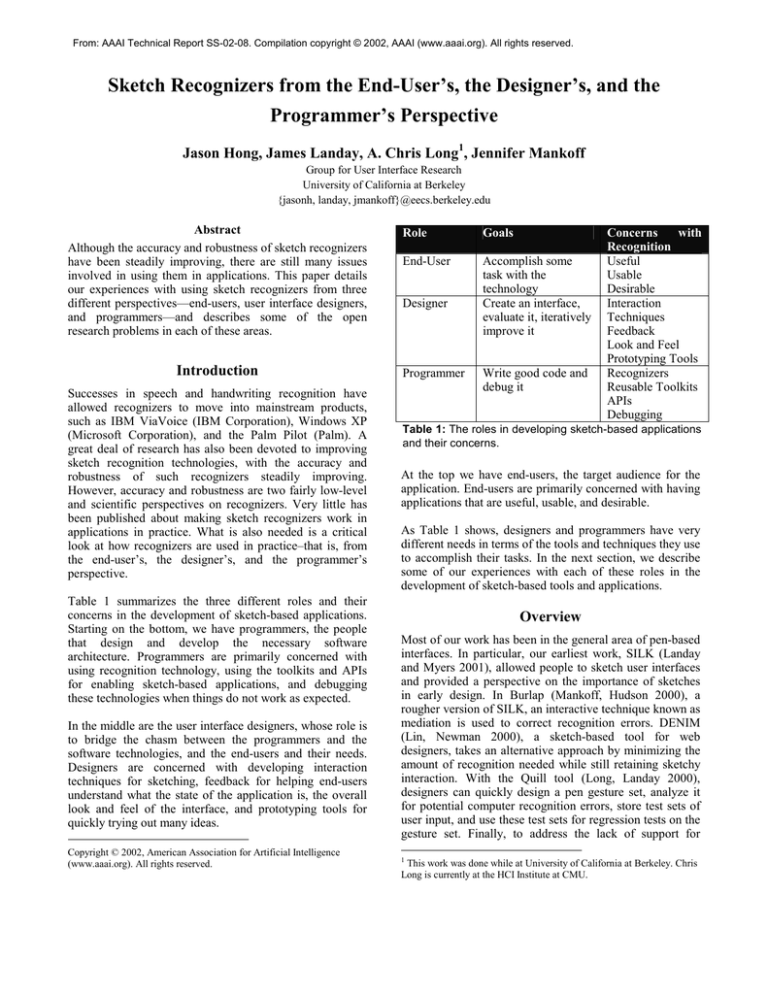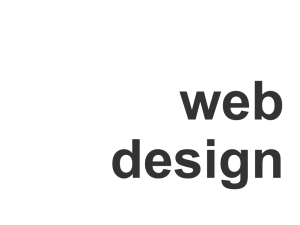
From: AAAI Technical Report SS-02-08. Compilation copyright © 2002, AAAI (www.aaai.org). All rights reserved.
Sketch Recognizers from the End-User’s, the Designer’s, and the
Programmer’s Perspective
Jason Hong, James Landay, A. Chris Long1, Jennifer Mankoff
Group for User Interface Research
University of California at Berkeley
{jasonh, landay, jmankoff}@eecs.berkeley.edu
Abstract
Although the accuracy and robustness of sketch recognizers
have been steadily improving, there are still many issues
involved in using them in applications. This paper details
our experiences with using sketch recognizers from three
different perspectives—end-users, user interface designers,
and programmers—and describes some of the open
research problems in each of these areas.
Introduction
Successes in speech and handwriting recognition have
allowed recognizers to move into mainstream products,
such as IBM ViaVoice (IBM Corporation), Windows XP
(Microsoft Corporation), and the Palm Pilot (Palm). A
great deal of research has also been devoted to improving
sketch recognition technologies, with the accuracy and
robustness of such recognizers steadily improving.
However, accuracy and robustness are two fairly low-level
and scientific perspectives on recognizers. Very little has
been published about making sketch recognizers work in
applications in practice. What is also needed is a critical
look at how recognizers are used in practice–that is, from
the end-user’s, the designer’s, and the programmer’s
perspective.
Table 1 summarizes the three different roles and their
concerns in the development of sketch-based applications.
Starting on the bottom, we have programmers, the people
that design and develop the necessary software
architecture. Programmers are primarily concerned with
using recognition technology, using the toolkits and APIs
for enabling sketch-based applications, and debugging
these technologies when things do not work as expected.
In the middle are the user interface designers, whose role is
to bridge the chasm between the programmers and the
software technologies, and the end-users and their needs.
Designers are concerned with developing interaction
techniques for sketching, feedback for helping end-users
understand what the state of the application is, the overall
look and feel of the interface, and prototyping tools for
quickly trying out many ideas.
Copyright © 2002, American Association for Artificial Intelligence
(www.aaai.org). All rights reserved.
Role
Goals
End-User
Accomplish some
task with the
technology
Create an interface,
evaluate it, iteratively
improve it
Designer
Programmer
Write good code and
debug it
Concerns
with
Recognition
Useful
Usable
Desirable
Interaction
Techniques
Feedback
Look and Feel
Prototyping Tools
Recognizers
Reusable Toolkits
APIs
Debugging
Table 1: The roles in developing sketch-based applications
and their concerns.
At the top we have end-users, the target audience for the
application. End-users are primarily concerned with having
applications that are useful, usable, and desirable.
As Table 1 shows, designers and programmers have very
different needs in terms of the tools and techniques they use
to accomplish their tasks. In the next section, we describe
some of our experiences with each of these roles in the
development of sketch-based tools and applications.
Overview
Most of our work has been in the general area of pen-based
interfaces. In particular, our earliest work, SILK (Landay
and Myers 2001), allowed people to sketch user interfaces
and provided a perspective on the importance of sketches
in early design. In Burlap (Mankoff, Hudson 2000), a
rougher version of SILK, an interactive technique known as
mediation is used to correct recognition errors. DENIM
(Lin, Newman 2000), a sketch-based tool for web
designers, takes an alternative approach by minimizing the
amount of recognition needed while still retaining sketchy
interaction. With the Quill tool (Long, Landay 2000),
designers can quickly design a pen gesture set, analyze it
for potential computer recognition errors, store test sets of
user input, and use these test sets for regression tests on the
gesture set. Finally, to address the lack of support for
1
This work was done while at University of California at Berkeley. Chris
Long is currently at the HCI Institute at CMU.
Figure 1. (a) The relationship between Designers and SILK/Burlap, Quill and DENIM. SILK/Burlap can generate a user
interface (UI); Quill can generate gesture sets, and DENIM is used to sketch Web pages. (b) The relationship between
Programmers, SATIN and OOPS. SATIN is used to build pen-based UIs while OOPS provides access to techniques for
mediating recognition errors. Both provide APIs for dealing with recognizers.
programmers, we developed two different toolkits, SATIN
(Hong and Landay 2000) and OOPS (Mankoff, Hudson
2000), which offer the APIs and algorithms necessary to
support programmers who are dealing with strokes and
recognizers as first class objects.
Figure 1 shows the relationships between the tools we
describe in this paper and End-Users, Designers, and
Programmers. Notice that the tools intend for use by
designers (SILK/Burlap, Quill, and DENIM) are used to
generate interfaces and web pages, things that will be used
directly by end-users. They all support quick prototyping
and iteration and require no programming. In contrast, the
tools intended for use by programmers provide
infrastructure, APIs, and library components that can be
used in application and UI development. They require
programming to be used and cannot support the same style
of quick prototyping. This meshes with the roles and needs
of developers and programmers described above.
We have examined the use of recognizers by all three of
these groups. There are some characteristics of recognizers
that impact people at each of these levels. The
characteristics we have focused on include: recognition
errors, the ability of strokes to be ambiguous, the
complexity of strokes, and issues in displaying both strokes
and the results of recognition. We summarize the lessons
we have learned about recognizers with respect to these
various roles, examining the strengths and weaknesses in
the state of the art, and conclude with suggestions for future
directions for research.
Tools for Designers
As stated, SILK supported designers in the task of quickly
prototyping user interfaces by sketching them (see Figure
2). Informal observations and discussions with designers
revealed that they liked to sketch out ideas because the
freeform nature allowed them to be more creative and
exploratory than if they were using a computer. Sketching
also made it easier to rapidly prototype and iterate on user
interfaces. These findings have been confirmed in other
studies (Black 1990, Goel 1995, Gross and Do 1996,
Newman and Landay 2000, Wagner 1990, Wong 1992).
Figure 2. SILK lets people sketch out user interfaces and
connect individual screens together.
In SILK, each ink stroke was processed immediately as it
was drawn. Although the ink was kept “as is” without
transforming its presentation, designers had to correct any
recognition errors in a separate window, since the system
always had to have the “correct” state for it to work
properly. This recognition feedback and correction would
often be distracting from the task at hand, namely user
interface design.
We investigated two approaches to dealing with this. In
Burlap (Mankoff, Hudson 2000), a rougher version of
SILK, an interactive technique known as mediation is used
to correct recognition errors (see Figure 3). Designers are
not required to correct any recognition errors until they
need to interact with a sketched component, for example in
preparation for a demo of the sketched system. At that
point, designers can select the correct choice from a list
displayed dynamically near the problem sketch, or redraw
the sketch if necessary. This was an attempt to minimize
the amount of recognition needed while still retaining
sketchy interaction.
Figure 3. Burlap is a rougher version of SILK that demonstrates how
mediators can be used to interactively deal with recognition errors.
DENIM (Lin, Newman 2000), a sketch-based tool for web
designers, pushed this approach even further by removing
recognition almost entirely from the design process while
retaining sketchy interaction (see Figure 4). Sketched
objects within a page are grouped by spatial and temporal
proximity, and sketched objects between two pages are
classified as arrows. DENIM was designed to be used more
for documenting ideas and letting humans recognize and
interpret things as opposed to the computer. Feedback from
end-users during usability tests and from people that have
downloaded DENIM has shown that this strategy is
surprisingly effective.
However, even though there is little recognition in DENIM,
we still observed designers encountering a number of
difficulties. One problem stems from the fact that sketchbased applications often have “invisible” interfaces. It is
not always clear what actions are and are not possible at
any given time. A related problem is with feedback.
Sometimes people were not sure if the system had “done
the right thing” after a stroke had been drawn, even though
we tried to minimize the amount of recognition involved.
Another problem is simply the individual variation between
people. Some people drew objects slightly skewed or a
little larger than what we had expected. This had little
effect on the ink, other than occasional unexpected
grouping, but had a serious impact on recognition of
gestures such as cut, pan, undo, and redo. This is important
because gestures are a common part of many sketch-based
interfaces, and often rely on the same kind of recognizers
used for understanding sketches.
Another broad problem faced by designers is in defining
what sketched objects can be recognized. When SILK was
developed, the only interface to the underlying Rubine
recognizer (Rubine, 1991) was a programmatic API. For
example, Figure 5 shows the definition of a horizontal
scrollbar in SILK. This approach made it difficult to
experiment with choices for the appearance of recognized
gestures, or to see if they were effective from an end-user
Figure 4. Two screenshots from DENIM, a sketch-based Web site
design tool for the early stages of design.
(and (contains-p container containee)
(rectangle-p container)
(rectangle-p containee)
(skinny-p container :horizontal)
Figure 5. Definition of a horizontal scrollbar in SILK.
that takes place when a stroke is recognized, while OOPS
treats the recognition results as first class input events,
allowing them to be sent to widgets or further recognized.
For example, in many sketch-based systems, strokes tend to
be processed only once, as they are drawn. Instead, OOPS
allows ambiguous states. OOPS can defer resolution of that
ambiguity, making automatic corrections as more sketches
and other contextual information comes along. If it is
necessary to involve the end-user in correction, OOPS
provides pluggable, extensible interface elements, called
mediators, for this purpose. A programmer may select
mediators for use in his application, and switch from one to
another without modifying any other aspect of his
application. Some examples of the mediators provided in
OOPS include a choice mediator, which displays a list of
options, and a repetition mediator, which lets end-users
repeat the input and try recognition again.
Figure 6. Quill is a tool that lets designers quickly create and
test pen gestures.
perspective. Another problem with this limited definition
is robustness. Sketches that were slightly off would not be
correctly recognized, even if end-users perceived it as such.
Thus, our experiences as developers of SILK showed us the
need for a tool to help support designers in the creation of
gesture sets to be recognized. Here our focus was on
supporting the creation of a gesture set that is both
accessible to users and easy for the recognizer to accurately
support. The result was the Quill tool (Long, Landay
2000), shown in Figure 6. With this tool, designers can
quickly design a gesture set, analyze it for potential
computer recognition errors, store test sets of user input,
and use these test sets for regression tests on the gesture
set.
Tools for Programmers
Our experiences as developers of SILK, Burlap, DENIM,
and Quill led to an understanding of a multitude of
problems relating to the creation of pen and recognitionbased user interfaces. In particular, there was a clear need
for APIs and algorithms that allow the use of strokes and
recognizers as first class objects. Here we highlight some
of those problems and then discuss SATIN (Hong and
Landay 2000) and OOPS (Mankoff, Hudson 2000), two
toolkits intend to address them.
One focus in these toolkits was on pluggability and reusability in the context of existing applications and
widgets. For example, in both SATIN and OOPS, a
programmer can easily switch the recognizer in use without
modifying other aspects of her application. SATIN also
gives programmers the ability to easily change the behavior
Because SILK and OOPS were only intended to support
programmers, there is only minimal support for quickly
designing and testing a sketch-based interface, meaning
that a large portion of the interface itself has to be
programmed and developed before it can be evaluated with
end-users.
Summary and Future Directions
From an end-user perspective, our research group has
developed two new ways in which recognizers are used.
The first is with informal user interfaces, which are
interfaces that support natural human input, such as speech
and writing, while minimizing recognition and
transformation of the input. These interfaces, which
document rather than transform, better support a user’s
flow state. The second is realizing that handling errors are
an intrinsic and essential part of recognizers, and that lowlevel programming support should be provided to make it
easier to defer mediation to end-users.
From a designer perspective, our research group has
created tools for developing and testing gesture sets, for
sketching user interfaces, and for sketching web pages.
Here we learned that sketching was an essential prototyping
tool in part because it encouraged a willingness to make
large changes to proposed designs and an ability to make
them easily and quickly.
From a programmer perspective, our research group has
developed two toolkits focusing on re-usability of behavior
and mediation. Here we looked at APIs for recognition and
dealing with strokes, and created libraries of mediators and
widgets for strokes.
Of course, each of the applications and tools discussed
above address only some of the issues faced by end-users,
designers, and programmers. A great deal of research is
still needed in other areas. For example, although OOPS
supports ambiguity and mediation, there are still many
issues involved in making this technique scale to hundreds
or even thousands of strokes. Additionally, although
strokes are often used to give commands to a system, most
mediators were developed to help support recognition of
data (for example letters and words).
Furthermore, it is still extremely difficult to build systems
with sophisticated and robust multistroke capabilities. In
SILK, multistrokes were defined fairly rigidly in the
programming language. More support is needed for
graphically defining multistrokes, either through grammars
or by example.
Also, there are still only a few interfaces to sketch
recognizers beyond programming APIs. Quill represents a
step forward in helping designers create and test singlestroke languages for recognizers, but there is still a long
ways to go before sketch recognition is made generally
accessible to all designers. Designers need prototyping
tools for letting them quickly create sketch-based
applications for desktops and PDAs, letting them easily
define what objects to recognize and what interactions are
allowed.
Lastly, two key usability issues are invisibility and
feedback. More techniques need to be developed to make
sketching more “self-revealing,” while at the same time
ensuring that it does not provide too much feedback that
distracts from the task at hand.
References
1. Black, A., Visible Planning on Paper and on Screen: The
Impact of Working Medium on Decision-making by
Novice Graphic Designers. Behaviour & Information
Technology, 1990. 9(4): 283-296.
2. Goel, V. 1995. Sketches of Thought. Cambridge, MA:
The MIT Press.
3. Gross, M.D. and Do, E.Y.-L. 1996. Ambiguous
Intentions: A Paper-like Interface for Creative
Design. In Proceedings of ACM Symposium on
User Interface Software and Technology: UIST
’96, 183-192. Seattle, WA: ACM Press.
4. Hong, J. and Landay, J.A. 2000. SATIN: A Toolkit for
Informal In-based Applications. In Proceedings of
User Interfaces and Software Technology: UIST
2000, pp. 63-72. San Diego, CA: ACM Press.
5. IBM Corporation, IBM Voice Systems.
http://www.ibm.com/software/speech
6. Landay, J.A. and Myers, B.A., Sketching Interfaces:
Toward More Human Interface Design. IEEE
Computer, 2001. 34(3): 56-64.
7. Lin, J.; Newman, M.W.; Hong, J.I.; and Landay, J.A.
2000. DENIM: Finding a Tighter Fit Between
Tools and Practice for Web Site Design. In
Proceedings of Human Factors in Computing
Systems: CHI 2000, 510-517. The Hague, The
Netherlands: ACM Press.
8. Long, A.C.; Landay, J.A.; and Rowe, L.A., Visual
Similarity of Pen Gestures. CHI Letters, 2000.
2(1): 360-367.
9. Mankoff, J.; Hudson, S.E.; and Abowd, G.D. 2000.
Providing Integrated Toolkit-Level Support for
Ambiguity in Recognition-Based Interfaces. In
Proceedings of Human Factors in Computing
Systems: CHI 2000, 368-375. The Hague, The
Netherlands: ACM Press.
10.
Microsoft Corporation, Microsoft Windows XP.
http://www.microsoft.com/windowsxp
11.
Newman, M.W. and Landay, J.A. 2000. Sitemaps,
Storyboards, and Specifications: A Sketch of Web
Site Design Practice. In Proceedings of Designing
Interactive Systems, DIS 2000, 263-274. New
York City: ACM Press.
12.
Palm, I. http://www.palm.com
13.
Wagner, A. 1990. Prototyping: A Day in the Life
of an Interface Designer, in The Art of HumanComputer Interface Design, B. Laurel, Editor.
Addison-Wesley: Reading, MA. p. 79-84.
14.
Wong, Y.Y. 1992. Rough and Ready Prototypes:
Lessons From Graphic Design. In Proceedings of
CHI '92: Human Factors in Computing Systems
Short Talks, 83-84. Monterey, CA: ACM Press.




